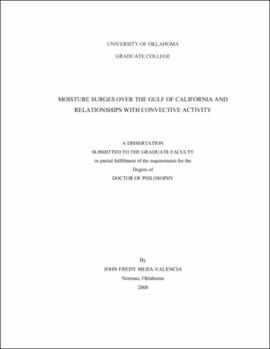| dc.contributor.advisor | Lamb, Peter||Douglas, Michael | |
| dc.creator | Mejia-Valencia, John F. | |
| dc.date.accessioned | 2019-04-27T21:31:23Z | |
| dc.date.available | 2019-04-27T21:31:23Z | |
| dc.date.issued | 2008 | |
| dc.identifier | 99265505902042 | |
| dc.identifier.uri | https://hdl.handle.net/11244/318907 | |
| dc.description.abstract | The North American Monsoon (NAM) is characterized by widespread convective activity and rainfall that is tied to key synoptic and sub-synoptic atmospheric circulation features during summer - from mid-June to September. The core monsoon region, particularly over southwestern United States and around the Gulf of California (GoC), often experiences atmospheric phenomena recognized in the literature as "moisture surges". These moisture surges represent one of the most important sources of rainfall variability in the NAM core region with important implications in the hydroclimate and the water resources management in this semiarid region. Although there are a number of studies relating NAM synoptic-scale conditions with moisture surges and regional rainfall patterns, the interactions between atmospheric phenomena of differing scales still remains under-investigated. | |
| dc.description.abstract | The overall objective of this research is to improve the understanding of how smaller-spatial scale atmospheric processes modify the evolution of larger-scale atmospheric conditions over the NAM domain. More specifically, this study aims to determine the relationship between organized mesoscale convective systems (MCS's) and moisture surges, and their associated synoptic forcings in the form of Tropical Easterly Waves (TEW), and eastern Pacific Tropical Storms (TS)/Tropical Cyclones (TC). Similarly, relationships were determined between MCS's and GoC low-level jet (GCLLJ). | |
| dc.description.abstract | The present research uses three approaches to determine the links between MCS's and moisture surges. A first component of the research consisted of a detailed analyses of a well-observed moisture surge event that occurred during the North American Monsoon Experiment (NAME-2004). Analyses of aircraft flight-level data, together with other special and routine observations are used to describe the four-dimensional structure of this surge event. Theory and observations indicate that this surge's leading edge resembles a solitary Kelvin wave during its initial stages. MCS convective outflows in the central-GoC were observed to modify northern GoC surge variability and the GCLLJ intensity. The observations highlighted the role of convective activity in modulating the surge and its subsequent evolution. | |
| dc.description.abstract | The second component of this research consists of a comprehensive climatological study using historical satellite-estimated MCS's, a multiyear set of surge events, the North American Regional Reanalysis (NARR) products, and microwave scatterometer SeaWinds (QuikSCAT) data. Climatological composites are created based on synoptic timescales features (such as TEWs and TSs/TCs) and intraseasonal variations (30-60 -day Madden-Julian Oscillation (MJO) variability), and are further stratified with respect to mesoscale rainfall variability in the NAMS core region. These results provided new insights into the nature of the GoC moisture flux variability and describe the influence of MCS's in modulating the intensity of moisture surges and the GCLLJ. Further, results revealed the role of MCS's in modulating the diurnal cycle of the GoC low-level circulation during "major surge", "minor surge", and "non-surge" environments. | |
| dc.description.abstract | In the third and final component of this research, numerical simulation experiments were performed using the Advance Research Weather and Research Forecasting (ARW V3.0) model to investigate the sensitivity of the model to those physical representations associated with convective processes in surge and non-surge synoptic-scale environments. The approach consisted of simulating features associated with mesoscale convective processes on different synoptic-scale background flows (e.g. during moisture surge and non-surge conditions). In the interest of simplicity, convective outflows, typically resulting from MCS events, were replaced by Cold Bubbles (CBs). Although several assumptions were made to replace the effect of convective activity by those of the CBs, this model configuration permitted evaluating the impact that CBs have on the regional flow during surge and non-surge conditions. The influence of CBs over the central-GoC coastal plains was found to be more pronounced for non-surge than for surge synoptic conditions. In particular, the GCLLJ variability and its intensity were larger when CBs were inserted. However, significant southeasterly low-level flow over the northern-GoC was mainly associated with those CBs inserted during the daytime. | |
| dc.description.abstract | Taken together, this research shows important associations between MCS's and moisture surges. Surges appear to modify the diurnal circulations along the GoC coastal plain, partly through MCS activity, which in turn enhances the offshore flow along the eastern GoC coast, which then enhances the nocturnal low-level jet over the northern GoC. Furthermore, the occurrence of MCS's over the southern GoC immediately before surge onset produces more intense moisture surges, regardless of the type of tropical synoptic-scale disturbance that is forcing the surge. Therefore, the correct simulation of MCS's (their timing and intensity) in the NAM core region has an upscale effect on the correct simulation of the GoC low-level flow with significant impact on the transient components of the NAMS. | |
| dc.format.extent | 169 pages | |
| dc.format.medium | application.pdf | |
| dc.language | en_US | |
| dc.relation.requires | Adobe Acrobat Reader | |
| dc.subject | Monsoons--North America | |
| dc.subject | Rain and rainfall--Southwestern States | |
| dc.subject | Rain and rainfall--Mexico--California, Gulf of | |
| dc.subject | Convection (Meteorology) | |
| dc.subject | Mesometeorology | |
| dc.title | MOISTURE SURGES OVER THE GULF OF CALIFORNIA AND RELATIONSHIPS WITH CONVECTIVE ACTIVITY | |
| dc.type | text | |
| dc.type | document | |
| dc.thesis.degree | Ph.D. | |
| ou.group | College of Atmospheric & Geographic Sciences::School of Meteorology | |
